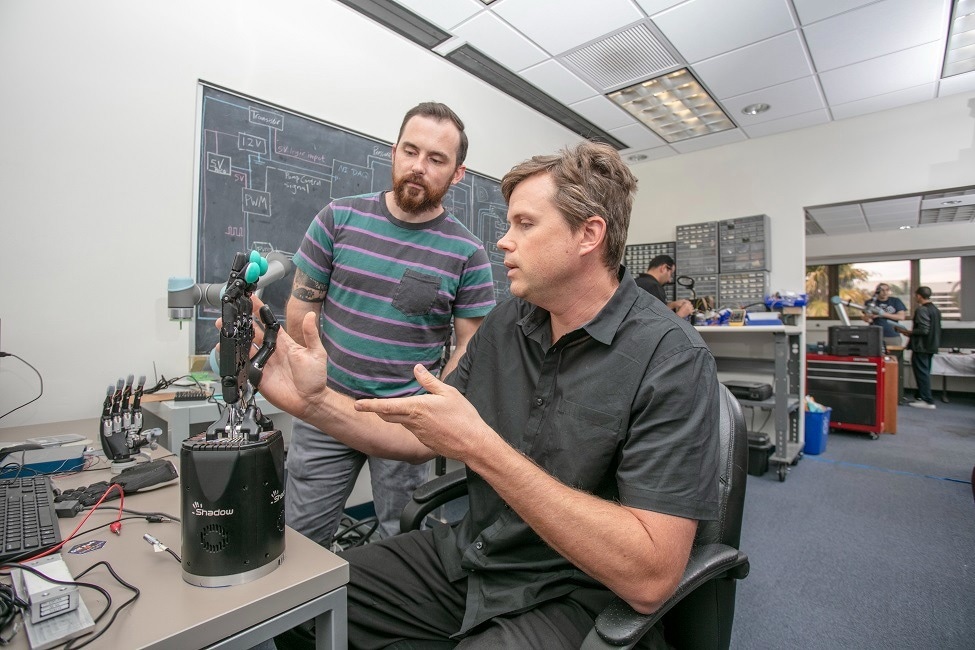AZoRobotics speaks with Dr. Erik Enegberg from Florida Atlantic University about his research into a wearable soft robotic armband. This could be a life-changing device for prosthetic hands users who have long-desired advances in dexterity.
Typing on a keyboard, pressing buttons on a remote control, or braiding a child’s hair has remained elusive for prosthetic hand users. How does the loss of tactile sensations impact limb-absent people’s lives?
Losing the sensation of touch has a profound impact on people’s lives. Some of the things that may seem simple and a part of everyday life, such as stroking the fur of a pet or the skin of a loved one, are a meaningful and fundamental way to connect with those around us for others. For example, a patient with a bilateral amputation has previously expressed concerns that he might hurt his granddaughter by accidentally squeezing her hand too tightly as he has lost tactile sensation.
What inspired your research into developing a wearable armband to help prosthetic hand users to grip objects?
I have always been fascinated with the complex process of manual dexterity. Thus, creating a wearable armband to help prosthetic hand users was a way to help limb-absent individuals recapture this fantastic capability for people who have lost a limb is a lifelong pursuit with high potential to help those in need that they have lost as a result of amputations.

Erik Engeberg, Ph.D., (seated) senior author, pictured with the dexterous artificial hand used for the study. (Image Credit: Alex Dolce).
Current users of myoelectric prosthetic hands can only control one grasp function at a time, even though modern artificial hands are mechanically capable of individual control of all five digits. Why is this?
Current myoelectric hands only have the ability to grasp one object at a time, and this is a tough problem to solve because of the training time, lack of sensation, and the size and weight constraints on wearable robotic devices like prosthetic limbs. The tradeoffs between function and cost also pose difficult dilemmas, but thankfully the trend is toward increasing functionality.
When attempting to grasp an object, what is more useful, haptic feedback or visual feedback?
Haptic feedback is absolutely critical in a variety of situations, such as when grasping a brittle object like an egg, where there is often no visually perceptible warning before it breaks. Haptic feedback is also really helpful when it comes to making ordinary and simple tasks much less demanding by providing an alternative method for situational awareness rather than relying purely on visual feedback.
Beyond these factors, the sense of touch strongly impacts many other things, including how often a person is willing to use a prosthetic hand and the kinds of careers that amputees can pursue.
How does a combination of haptic/touch sensation feedback, electromyogram (EMG) control, and an innovative wearable soft robotic help to revolutionize the way current and future artificial hands are controlled by limb-absent people?
Our work has shown that people can use multiple channels of haptic feedback at the same time to precisely control the forces of multiple fingers simultaneously, even when visual feedback was blocked. This has profound implications for the future development of refined interfaces that can enable higher-level tasks like playing musical instruments or sports.
Can you give an overview of how your armband works?
The soft robotic armband is bimodal, conveying both steady-state sensations of pressure and rapidly adapting sensations of touch. There are soft actuators for the steady-state pressure feedback that are basically like smart balloons in which the internal pressures can be controlled to be proportional to prosthetic fingertip forces. There are also the vibrotactile buzzers similar to those in cell phones that convey discrete events, such as whether a grasped object is broken or slips.
Research Footage of Novel Wearable Armband and Prosthetic Hand
Video Credit: Florida Atlantic University.
Did you come across any challenges during your research, and if so, how did you overcome them?
The engineering challenge in upper limb prosthetics is complex and interconnects with multiple other disciplines. I am thankful to work with a great team to help address these tough problems, and I am also very grateful to the upper limb amputees who have donated their time to help the process.
How did you test the efficacy of your dexterous artificial hand? What did your results conclude?
To test the effectiveness of our dexterous artificial hand, we designed a battery of tests, including a comparison between transporting one object at a time or two objects simultaneously. We showed that people were able to save a lot of time by multitasking.
Furthermore, people could also perform other tasks simultaneously, such as holding a card between the index and middle fingers while opening a water bottle at the same time with the same hand. Another simultaneous control function that was able to be carried out was the capacity to grasp and hold an object while flipping a light switch at the same time. These were just several concrete examples to demonstrate the new potential for multitasking with haptic feedback in a precisely controlled manner.
How quickly were participants able to harness the multitasking functionality of the EMG-controlled artificial hands?
Subjects were able to integrate multiple channels of bimodal touch sensations into their dexterous robotic hand control strategies after two training sessions of 1-2 hours apiece.
This is a great advancement and shows great promise for the future commercialization and implementation of the technology.
How will such a device impact the lives and well-being of limb-absent individuals?
This device will have a strong impact on the lives of limb-absent individuals, potentially improving lives in the future by taking a step toward more seamless device integration into everyday tasks that could lay the foundation for high-level functionality, such as playing a musical instrument or sports.
Ultimately, and one of the most crucial aspects of this kind of development is that it could open new career pathways for amputees, enhancing their quality of life.
What are the next steps for your research?
After the success of our initial study, we are now preparing a take-home version of the soft robotic armband so that it can be used in the tasks that are typically undertaken on a daily basis in the home environment. This will give us more insights into how to customize the design for specific people.
About Dr. Erik Enegberg
 Dr. Erik D. Engeberg is a Professor in the Department of Ocean & Mechanical Engineering at Florida Atlantic University (FAU). He earned his Ph.D. in mechanical engineering from the University of Utah in 2008. He has been the recipient of numerous awards from federal agencies in the USA, including the National Institutes of Health, the National Science Foundation, the Department of Energy, and the Office of Naval Research. He received the most notable article award from the journal Sensors, the 2021 faculty research award at FAU, and was the 2020 researcher of the year at FAU. He was honored with the outstanding engineering achievement merit award by the Engineers’ Council and the outstanding reviewer award from the Journal of Neural Engineering. He received the best paper and presentation awards at the 2018 Florida Conference on Recent Advances in Robotics, the most cited article award from the Journal of Precision Engineering and Manufacturing and the top 5 most cited article award from Sensors and Actuators A: Physical.
Dr. Erik D. Engeberg is a Professor in the Department of Ocean & Mechanical Engineering at Florida Atlantic University (FAU). He earned his Ph.D. in mechanical engineering from the University of Utah in 2008. He has been the recipient of numerous awards from federal agencies in the USA, including the National Institutes of Health, the National Science Foundation, the Department of Energy, and the Office of Naval Research. He received the most notable article award from the journal Sensors, the 2021 faculty research award at FAU, and was the 2020 researcher of the year at FAU. He was honored with the outstanding engineering achievement merit award by the Engineers’ Council and the outstanding reviewer award from the Journal of Neural Engineering. He received the best paper and presentation awards at the 2018 Florida Conference on Recent Advances in Robotics, the most cited article award from the Journal of Precision Engineering and Manufacturing and the top 5 most cited article award from Sensors and Actuators A: Physical.
Disclaimer: The views expressed here are those of the interviewee and do not necessarily represent the views of AZoM.com Limited (T/A) AZoNetwork, the owner and operator of this website. This disclaimer forms part of the Terms and Conditions of use of this website.